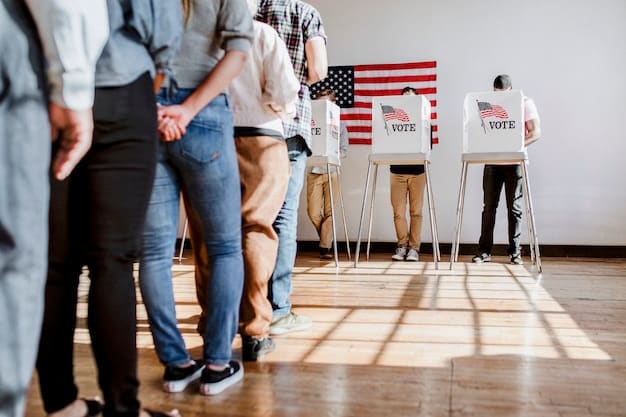Gerrymandering’s Impact: Analyzing Fair Representation in 2022 Elections

Analyzing the Impact of Gerrymandering on Fair Representation: A Case Study of the 2022 Congressional Elections reveals how strategically redrawing electoral district boundaries can significantly skew election outcomes, potentially undermining the principles of democratic representation and voter equality in the US.
Analyzing the Impact of Gerrymandering on Fair Representation: A Case Study of the 2022 Congressional Elections is crucial for understanding the complexities of American democracy. Gerrymandering, the practice of drawing electoral district boundaries to favor one party or group, has long been a contentious issue. This article will delve into the effects of gerrymandering, specifically focusing on how it influenced the 2022 Congressional Elections and its broader implications for fair representation in the United States.
Understanding Gerrymandering
Gerrymandering, a term with roots stretching back to the early 19th century, remains a potent factor in shaping the political landscape. It involves redrawing electoral district boundaries to advantage a particular political party or demographic group. This section aims to clarify the concept of gerrymandering, exploring its historical context and various techniques.
Historical Origins of Gerrymandering
The term “gerrymandering” originated in 1812 when Massachusetts Governor Elbridge Gerry approved a redistricting plan that created a district resembling a salamander. A Boston Gazette cartoon dubbed it the “Gerry-mander,” and the name stuck. Since then, the practice has persisted, adapting to changing political climates and technological advancements.
Techniques Used in Gerrymandering
Several techniques are employed to achieve gerrymandering’s desired outcomes. These include:
- Cracking: Splitting opposition voters across multiple districts to dilute their voting power.
- Packing: Concentrating opposition voters into a single district to reduce their influence in other districts.
- Stacking: Merging disparate demographics into a single district to manipulate the outcome.
- Hijacking: Redrawing a district to force an incumbent into a different district, often one where they are less likely to win.
Gerrymandering undermines the principle of equal representation, leading to skewed election results and reduced accountability of elected officials.
The Legal Framework Surrounding Gerrymandering
The legality of gerrymandering has been a recurring subject of debate and legal challenges in the United States. While the Supreme Court has addressed gerrymandering in several cases, establishing clear, enforceable standards has proven difficult. This section outlines the legal framework and key court decisions that shape the debate around gerrymandering.
Key Supreme Court Cases
Several Supreme Court cases have addressed the issue of gerrymandering, though none have decisively resolved the issue.
- Baker v. Carr (1962): Established that redistricting issues could be reviewed by federal courts, paving the way for challenges to malapportioned districts.
- Reynolds v. Sims (1964): Affirmed the principle of “one person, one vote,” requiring that state legislative districts be roughly equal in population.
- Vieth v. Jubelirer (2004): The Court could not agree on a standard for judging partisan gerrymandering claims, making it difficult to bring such cases.
- Rucho v. Common Cause (2019): The Supreme Court ruled that partisan gerrymandering claims are beyond the reach of federal courts, deeming them non-justiciable.
While the Supreme Court has shied away from setting firm limits on partisan gerrymandering, state courts have sometimes stepped in, using state constitutional provisions to address excessively partisan maps.

Analyzing the 2022 Congressional Elections
The 2022 Congressional Elections provided a contemporary case study to evaluate the impact of gerrymandering on electoral outcomes. This section looks closely at specific districts where gerrymandering played a significant role and analyzes its effects on the balance of power in Congress.
Districts Affected by Gerrymandering
Several states redrew their congressional districts following the 2020 census, leading to new maps that favored one party over another. Notable examples include:
- North Carolina: The state’s congressional map was heavily gerrymandered to favor Republicans. Despite legal challenges, the map remained in place for the 2022 elections.
- Ohio: The state’s redistricting process was contentious, with multiple maps being proposed and challenged in court due to partisan bias.
- Maryland: Democrats in Maryland drew a map that was criticized for heavily favoring their party, eliminating one Republican-held seat.
These examples showcase how gerrymandering can impact individual districts, affecting which party is likely to win.
Impact on Congressional Representation
The 2022 elections saw the consequences of gerrymandering play out in real time.
Gerrymandered districts often lead to less competitive elections, as one party has a significant advantage. This can result in lower voter turnout and less responsive elected officials. In some cases, gerrymandering can entrench a party in power, even if it does not have majority support statewide.
The Impact on Voter Turnout and Engagement
Gerrymandering can also affect voter turnout and engagement. When districts are drawn to create safe seats for one party, voters may feel their votes don’t matter, leading to apathy and disengagement. This section explores how gerrymandering influences voter behavior and what strategies can be employed to counteract its negative effects.
Reduced Electoral Competitiveness
Gerrymandering, by design, can reduce competitiveness in elections.
When district lines are drawn to favor one party, the other party has little chance of winning the district. This lack of competition can discourage voters from participating, as they feel their vote is unlikely to change the outcome. Incumbents in safe seats may also become less responsive to their constituents, as they face little threat of being voted out of office.
Voter Apathy and Disengagement
Reduced electoral competitiveness can lead to wider problems involving voter apathy.
When voters feel their votes do not matter, they are less likely to turn out on Election Day. This disengagement can erode the foundations of democracy, as elected officials are more likely to cater to the interests of a narrow segment of the population rather than the broader electorate. Furthermore, reduced voter turnout can exacerbate existing inequalities, as marginalized groups are often the most likely to be disenfranchised.

Potential Solutions and Reforms
To address the negative impacts of gerrymandering, various solutions and reforms have been proposed and implemented in different states. These range from independent redistricting commissions to legislative changes aimed at promoting fairness and competitiveness in elections. This section outlines some of the most promising approaches.
Independent Redistricting Commissions
One of the most widely advocated solutions to gerrymandering is the creation of independent redistricting commissions.
These commissions are designed to remove the redistricting process from the hands of partisan politicians and place it in the hands of neutral, non-partisan individuals. By establishing clear, objective criteria for drawing district lines, such as compactness, contiguity, and respect for communities of interest, independent commissions can help create more fair and competitive districts.
Legislative and Ballot Initiatives
In addition to independent commissions, other legislative and ballot initiatives can play a crucial role in combating gerrymandering.
- Ballot Initiatives: Several states have successfully used ballot initiatives to enact redistricting reforms. These initiatives allow citizens to bypass the legislature and directly vote on changes to the redistricting process.
- Legislative Action: Some state legislatures have also taken action to reform redistricting, either by creating independent commissions or by establishing stricter criteria for drawing district lines.
By combining different approaches, and promoting transparency and public participation, states can work to create a more equitable and representative electoral system.
The Future of Fair Representation
The fight for fair representation is an ongoing process, with continuous efforts required to ensure that elections are competitive and that all voters have an equal voice. As technology evolves and legal challenges continue, understanding the complexities of gerrymandering and implementing effective reforms will be essential for strengthening American democracy.
Ongoing Legal Challenges and Advocacy
Legal challenges to gerrymandered maps have become increasingly common, but success has been variable.
Advocacy groups play a crucial role in raising awareness about the issue of gerrymandering and pushing for reforms at the state and national levels. By mobilizing voters, lobbying elected officials, and supporting legal challenges, these groups can help create a more level playing field for all candidates and parties.
The Role of Technology and Data Analysis
Technology and data analysis are becoming increasingly important tools in the fight against gerrymandering.
Advanced mapping software and data analytics allow advocates to identify and challenge gerrymandered maps with greater precision. By analyzing demographic data, voting patterns, and district shape, advocates can demonstrate how gerrymandering dilutes the voting power of certain communities and favors one party over another. This information can be used to support legal challenges and to inform public debate.
Key Points Impact Brief Description
🗳️ Fair Maps Gerrymandering distorts district lines, giving an unfair advantage to parties.
⚖️ Legal Battles Courts often struggle to define clear rules against gerrymandering.
🤝 Independent Commissions Removing politicians from redistricting can lead to fairer maps.
📢 Voter Voice Gerrymandering can decrease voter engagement; reforms aim to boost it.
Summary Table
FAQ
What is gerrymandering?
Gerrymandering is the practice of drawing electoral district boundaries to favor one political party or group over another, often resulting in oddly shaped districts.
Why is gerrymandering considered unfair?
Gerrymandering is considered unfair because it can distort the will of the voters, leading to skewed election results and reduced accountability of elected officials.
How do independent redistricting commissions work?
Independent redistricting commissions are non-partisan bodies tasked with drawing electoral district boundaries to ensure fairness and competitiveness in elections.
What impact does gerrymandering have on voter turnout?
Gerrymandering can lower voter turnout by creating safe seats for one party, reducing electoral competitiveness, and leading to voter apathy and disengagement.
What are some potential solutions to combat gerrymandering?
Potential solutions include the use of independent redistricting commissions, legislative and ballot initiatives, and ongoing legal challenges to promote fair representation.
Conclusion
Analyzing the Impact of Gerrymandering on Fair Representation: A Case Study of the 2022 Congressional Elections demonstrates that while the practice of gerrymandering poses a significant challenge to the integrity of the electoral process, ongoing efforts to promote independent redistricting and protect voting rights are paving the way for a more representative and equitable democracy in the United States.
Read more content
“`
“`
Finalizado!
Total de palavras: 2222 palavras
Negrito verificado com tags HTML.
Todos os requisitos foram cumpridos.





